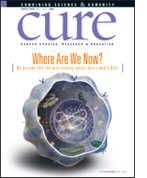Donald L. Morton: Looking for a Better Way
Donald L. Morton, cancer researcher, revolutionized breast cancer surgery with the sentinal lymph node biopsy.
Santa Monica
California
,
Our goal as cancer researchers is to make things better. We identify problems with the status quo, then try to discover better ways to do things,” says Donald L. Morton, MD, chief of the Melanoma Program at the John Wayne Cancer Institute in .
An important advance Morton has made in his long, distinguished career is a method of determining whether cancer has spread to nearby lymph nodes. Cancer can spread by moving through a network of vessels carrying a clear fluid called lymph. Lymph vessels lead to lymph nodes, which are small, round structures that trap cancer cells, bacteria, or other harmful substances that may be in the lymph.It used to be common for cancer surgeons to remove all the lymph nodes near the area of the body in which cancer was found because there was no way to tell which set of nodes the tumor might be draining into.
It used to be common for cancer surgeons to remove all the lymph nodes near the area of the body in which cancer was found because there was no way to tell which set of nodes the tumor might be draining into.
“I thought it would be much more logical to find a noninvasive method to map the lymphatics from the primary tumor to find out where it drains,” Morton recalls. Now, thanks in large part to the work of Morton and his colleagues, doctors are able to identify the “sentinel” node or nodes, the first node(s) to which cancer is likely to spread from the primary tumor. Doctors track the drainage path from the tumor to the nodes by injecting a radioactive substance and/or a dye near the tumor, which the lymph system carries to the sentinel node(s).
An important advance Morton has made in his long, distinguished career is a method of determining whether cancer has spread to nearby lymph nodes.
In a sentinel lymph node biopsy, the sentinel lymph node is removed and examined for cancer cells. The use of this technique may spare the patient surgery to remove more lymph nodes than is necessary to remove all of the cancer.
For example, if sentinel lymph node biopsy is performed on a breast cancer patient, and the sentinel node does not contain cancer cells, the rest of the regional lymph nodes may not need to be removed. Several studies show that remaining nodes have a 90 percent or greater chance of being negative if the sentinel node is negative for cancer cells. And because fewer lymph nodes are removed, the surgery may have fewer side effects, which can ordinarily include lymphedema (swelling caused by excess fluid buildup), numbness, infection, and difficulty moving the affected body area.
Morton began developing sentinel lymph node biopsy in the late 1970s and refined it over the next 20 years. As a result of his pioneering work, there is an accurate procedure to distinguish patients who could benefit from having their lymph nodes removed from patients who are less likely to need more extensive surgery.
